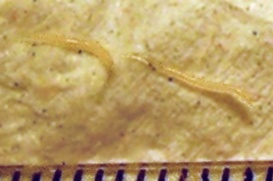Oxyuridae
Oxyuridae is a family of parasitic worms belonging to the order Oxyurida, which is part of the class Nematoda. Members of this family are commonly known as pinworms or threadworms and are notable for their small size and white color. The most well-known species within this family is Enterobius vermicularis, commonly referred to as the human pinworm, which is a significant cause of enterobiasis in humans, especially among children.
Characteristics[edit | edit source]
Members of the Oxyuridae family are characterized by their slender, thread-like appearance. They possess a simple digestive system, starting with a mouth equipped with three lips, leading to a straight intestine and ending in a short anal opening. The males are generally smaller than the females, with the latter having a sharply pointed tail. Reproduction in Oxyuridae is sexual, with females laying a large number of eggs outside the host's body, typically around the anal area, leading to the characteristic itching associated with pinworm infections.
Life Cycle[edit | edit source]
The life cycle of Oxyuridae species, particularly Enterobius vermicularis, involves several stages. The cycle begins when eggs are ingested, usually due to contaminated hands or food. Once inside the host's intestine, the eggs hatch into larvae, which mature into adults. The female worms then migrate to the anus to lay eggs, causing itching. The scratching of the affected area can lead to re-ingestion of the eggs, perpetuating the cycle. This direct life cycle does not require an intermediate host, making transmission easier and more common.
Disease and Treatment[edit | edit source]
Infection with Oxyuridae species, especially Enterobius vermicularis, leads to a condition known as enterobiasis. Symptoms include nocturnal anal itching, restlessness, and sometimes digestive disturbances. Diagnosis is often made using the "tape test," where adhesive tape is applied to the perianal area to collect eggs for microscopic examination.
Treatment typically involves the administration of anthelmintic medications, such as mebendazole or albendazole, which are effective in eliminating the worms. It is also essential to maintain good hygiene practices, such as regular hand washing and laundering of bedding and clothing, to prevent reinfection and transmission to others.
Distribution and Public Health Impact[edit | edit source]
Oxyuridae species are distributed worldwide, with Enterobius vermicularis being one of the most common helminthic infections in temperate and cooler regions. The high prevalence of pinworm infection is attributed to the ease of transmission and the ability of eggs to survive for extended periods in the environment. Pinworm infections are particularly common in crowded settings, such as schools and daycare centers, leading to significant public health challenges in managing outbreaks.
Conclusion[edit | edit source]
The Oxyuridae family, particularly through its member Enterobius vermicularis, plays a significant role in human parasitic diseases. Understanding the life cycle, transmission, and treatment of pinworm infections is crucial for effective control and prevention measures. Public health efforts focus on hygiene education, prompt treatment of infected individuals, and environmental sanitation to reduce the incidence of enterobiasis.
Translate: - East Asian
中文,
日本,
한국어,
South Asian
हिन्दी,
தமிழ்,
తెలుగు,
Urdu,
ಕನ್ನಡ,
Southeast Asian
Indonesian,
Vietnamese,
Thai,
မြန်မာဘာသာ,
বাংলা
European
español,
Deutsch,
français,
Greek,
português do Brasil,
polski,
română,
русский,
Nederlands,
norsk,
svenska,
suomi,
Italian
Middle Eastern & African
عربى,
Turkish,
Persian,
Hebrew,
Afrikaans,
isiZulu,
Kiswahili,
Other
Bulgarian,
Hungarian,
Czech,
Swedish,
മലയാളം,
मराठी,
ਪੰਜਾਬੀ,
ગુજરાતી,
Portuguese,
Ukrainian
Navigation: Wellness - Encyclopedia - Health topics - Disease Index - Drugs - World Directory - Gray's Anatomy - Keto diet - Recipes
Search WikiMD
Ad.Tired of being Overweight? Try W8MD's physician weight loss program.
Semaglutide (Ozempic / Wegovy and Tirzepatide (Mounjaro) available.
Advertise on WikiMD
WikiMD is not a substitute for professional medical advice. See full disclaimer.
Credits:Most images are courtesy of Wikimedia commons, and templates Wikipedia, licensed under CC BY SA or similar.
Contributors: Prab R. Tumpati, MD

